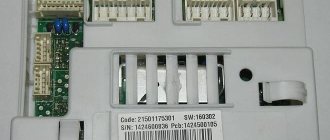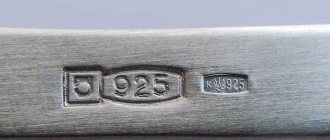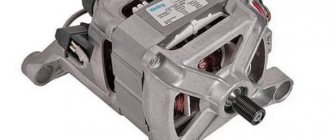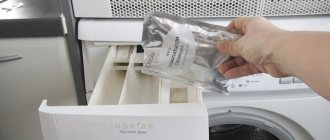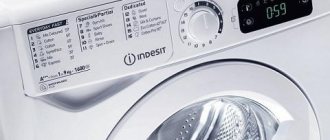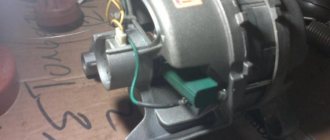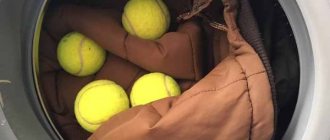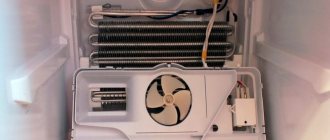The reasons are not serious
Undoubtedly, when a washing machine does not spin, the reason may lie in various parts of the unit and this does not always indicate a serious breakdown.
As a rule, the owners are to blame for why the washing machine stopped spinning.
After all, we all often forget about the need for operating instructions. We believe that since the machine spins, rinses and eventually squeezes things out in the drum, then it will always do this. But the spin cycle in the washing machine may stop functioning due to your clothes, or rather, an excess amount of them or washing heavily soiled clothes.
Drum overload with laundry
Surely you have noticed that in order to spin out your washed clothes, the machine must accelerate properly (about 600-800 rpm). Naturally, in order for it to accelerate, it should not be overfilled.
Therefore, when you decide to wash a bulky item (blanket, pillow, a lot of bed linen or down jackets, jackets), keep in mind that the weight of the wet fabric will become several times heavier. If you put too many things in the washing machine, then if the machine does not spin the item at the end of the program, then the reason may be due to overload.
Sometimes there are problems with imbalance. If, while rotating the drum, your washing machine knocks things into a non-uniform lump, then after several unsuccessful attempts it will not be able to squeeze out this lump. You will end up with wet laundry.
The reason is the drain filter
Another fairly common and harmless reason why the washing machine does not spin your clothes is a clogged filter. The causes of the malfunction are in the drain pump, which, due to a dirty filter, cannot drain water.
As a rule, if the washing machine does not spin due to a dirty pipe or filter, then you may notice the following behavior of the machine:
- Premature program stop.
- In various modes, the spin cycle does not work correctly, but in some modes everything is fine.
- When draining, uncharacteristic sounds appear.
Spin is programmatically disabled in the settings or a gentle wash is used
Often, the answer to the question why the washing machine does not spin clothes is an error in the program, and this very error was made by you, not the washing machine. This problem occurs on machines with mechanical rather than touch controls.
Simply put, when you set a program on which, say, “Cotton” was set, and next to it was the “Hand Wash” mode, the mode could skip even half a division.
As a result of this accident, the Zanussi, LV, Ariston, Whirlpool, Beko and any other machine stopped spinning. More precisely, a spin that suddenly stops working can be caused by ordinary inattention and a program change, so this is not a serious problem.
Discharge of waste water is not possible
It’s another matter if, after spinning, the water does not drain from the drum. Most likely, this is due to a non-functioning drain system - the washer cannot empty the tank due to a faulty pump, a blocked impeller or a blockage. To understand why the failure occurred and what to do, you will have to sequentially check all the identified problems.
- Eliminate sewer blockage. First, covering the hole with your hand, disconnect the drain hose from the sewer pipe and lower it into the bathtub or sink. The common drain may be clogged.
- We probe the hose. Next, carefully inspect the drain hose for blockages and kinks. If seals or foreign objects are noticed, the corrugation is disconnected and washed under the tap.
- Checking the filter. The garbage filter is located in the lower right corner of the machine behind the rectangular technical hatch. We pry up the last one with a screwdriver, remove it and, replacing the basin, unscrew the filter nozzle. All adhered dirt must be cleaned off.
- We look at the impeller and pump. The hole freed from the filter is illuminated with a flashlight. You need to find the snail, remove hair and lint from the blades, clean the pump body and “ring” all contacts with a multimeter.
The garbage filter is unscrewed strictly clockwise!
If the problem is a faulty pump or a damaged filter, then repair will not help - replacing broken parts is indicated. Once all the manipulations have been completed, you should assemble the machine and carry out a test wash. An empty drum after spinning will eliminate the fault of the drain system.
Serious damage
If you have checked all the possible above-mentioned malfunction options and your Atlant, Ldzhi or any other brand of washing machine still spins after washing, but does not spin as before, then you need to proceed with a more thorough inspection and prepare for more serious breakdowns.
Let's look at the main types of malfunctions due to which the machine does not spin the laundry at all or only does it every once in a while.
Water level sensor
A sensor with wires that regulates the level of collected water is called a pressure switch. This sensor carries a level function, due to which the washing machine collects the amount of liquid required for the selected program.
If it burns out or the tube leading to it becomes clogged, the Electrolux machine will not be able to squeeze things out properly. The pressure switch is located at the top of the washing unit, and to get to it you will need to remove the cover. But remember that it is better to entrust the level repair procedure to a specialist.
Engine speed sensor
Another sensor, called a tachometer, may be to blame for why the washing machine does not cope with its duties. Typically, the tachometer performs the function of a speed controller, due to which it transmits information about the spin force to the main one.
When the speed sensor becomes unusable, you will be able to wash things, but it will not be able to provide information about the spin force and, as a result, you will get wet laundry. Since the sensor is an electronic device, it may become unusable over time.
But sometimes the cause of its malfunction is a simple shift from its rightful place due to improper operation of the washing machine.
The engine has failed
As in the previous case, a malfunction of the engine leads to the machine being unable to determine the number of revolutions required for washing.
Usually, if such a problem occurs in the engine, you may notice poor performance, as a result of which things also remain wet and need an additional spin. As a result of abrasion of the graphite brushes, the winding shorts or breaks completely and the motor fails.
Electronic module
If the BEKO washing machine does not spin things properly or skips this step altogether and ends the program before the scheduled time, then the electronic module may be the reason why the spin does not work.
If the engine doesn't work
To repair the engine, you will need to disassemble the housing. You must first photograph all the fasteners and wires, then they can be removed. The photo will be needed when returning the engine to its place and connecting the wires. After removing the engine, the brushes are checked for wear by measuring their length. If they do not reach 0.5 cm, then it is time to replace them. You need to inspect the engine for water leaking into it. If you have no experience in repairing engines or control modules, then only professionals will help.
Special cases: different models
Of course, the reasons for failures of one washing machine manufacturer do not always coincide with others; sometimes this also applies to models of the same brand.
The thing is that some malfunctions are associated with mechanical damage to parts, and some directly with the program.
Almost all models of the companies Zanussi, Indesit, Bosch, Kandy, Samsung, Lzh and others can be damaged due to the breakdown of such parts as heating elements, pumps, level sensors and pumps with belts.
There's something extra in the tank
Jamming of the drum by a foreign object also leads to poor-quality spinning. Keys or a coin left in your pocket fall into the tank, and then awkwardly “stand up” and prevent the tank from rotating. You must act immediately, otherwise the walls of the containers, the market price of which is comparable to a new machine, will be damaged.
Before disassembling the machine, it is worth confirming the “diagnosis”. You need to disconnect the equipment from the power supply, drain the water, open the hatch and spin the drum. If rotation is difficult, a creaking or crackling sound is heard, it means there is a foreign object inside.
We proceed like this:
- disconnect the machine from the sewer and water supply;
- move away from the wall;
- remove the back panel;
- we find the heating element;
- photograph the “chip” with wires;
- unhook the wiring;
- unscrew the holding bolts;
- remove the heating element to the side;
- shine a flashlight through the hole;
- We remove the stuck object by hand or with a metal hook.
We recommend not to stop there, but to take advantage of the situation and carry out an extraordinary cleaning of the heating element. Then we assemble the machine and check whether the drum spins freely. Then we run a test wash and monitor the spin quality. If things remain wet, we look for the problem further.
Correct operation
If you are faced with the problem that the washing machine has stopped spinning things, then you have neglected the operating recommendations.
As you know, a washing machine wrings things out only after washing, but the correctness of the latter is not so difficult to maintain.
To keep your machine always in shape, you need to adhere to the following:
- Empty your pockets of foreign iron objects.
- Use special bags for washing underwear.
- Sort clothes by size.
- Consider the dimensions and maximum capacity of the unit.
- Connect the machine to special surge protective devices.
Perhaps it's an imbalance
The most common cause of missing spin is imbalance. In simple words, when the drum spins, it gets knocked off its given axis and begins to hit the walls of the tank. For safety reasons, the machine stops rotating, the cycle ends 7-15 minutes earlier, and the clothes are not wrung out.
Failure to comply with drum loading standards leads to imbalance: overloading or underloading. Clumping of linen also disrupts the balance when, for example, it gets stuffed into a hole in a duvet cover and is distributed unevenly along the walls. Modern machines are able to detect suspicious swaying and display the corresponding error code on the display. Old models only stop the cycle, leaving users confused.
If you suspect an imbalance, you should:
- wait until the machine turns off the UBL;
- open the hatch and assess the situation (overload, underload or knockdown);
- eliminate the problem (by pulling out some of the laundry, adding items or breaking up the lump and distributing the clothes in the drum);
- close the door;
- activate spin;
- make sure the laundry is wrung out.
Failure to comply with loading standards leads to drum imbalance!
It is better to avoid imbalance and constantly monitor the number of items washed. Unbalancing destroys the bearing assembly, drum shaft and shock absorption system, not to mention possible internal mechanical damage. Be sure to remember both the upper and lower limits (both are indicated in the factory instructions). Thus, the Atlant washing machine with a capacity of up to 5 kg washes 1 kg of laundry at a time, and with a load of 8-9 kg the minimum is set to 2.5 kg.
The machine freezes during the spin cycle
Less often, a problem occurs with the “brain” of the washing machine – the control module. In this situation, the machine begins to work unpredictably: it “forgets” to rinse the laundry, cancels the spin cycle, or simply freezes in the middle of the cycle.
It is not recommended to repair the board yourself, since one careless movement will aggravate the situation until it breaks down beyond repair.
You can only visually assess the condition of the module. To do this, disconnect the machine from the power supply, remove the top cover, pull the powder receptacle towards you and carefully unscrew the screws holding the front panel. We release the wiring and look for visible damage on the surface of the board. If there are none, contact the service center.
